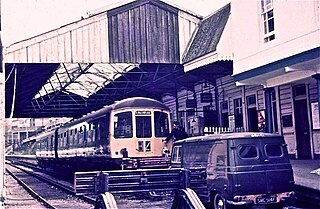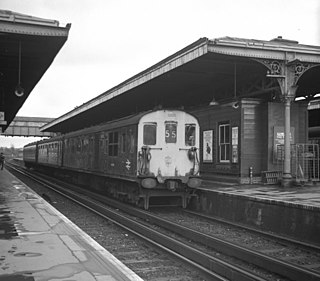
A diesel multiple unit or DMU is a multiple-unit train powered by on-board diesel engines. A DMU requires no separate locomotive, as the engines are incorporated into one or more of the carriages. Diesel-powered single-unit railcars are also generally classed as DMUs. Diesel-powered units may be further classified by their transmission type: diesel–mechanical DMMU, diesel–hydraulic DHMU, or diesel–electric DEMU.

The British Rail Class 205 (3H) diesel-electric multiple units were built by BR at Eastleigh from 1957 to 1962, and in service for 47 years from BR Southern Region to Connex South Central and finally to the Southern franchise. They were eventually replaced by Class 171 Turbostar units.

The British Rail Class 207 (3D) diesel-electric multiple units were built by BR at Eastleigh in 1962. The fleet had a lifespan of 42 years. The Southern Region class 201 to 207 DEMUs are nicknamed 'Thumpers' due to the noise their engine units make.

The British Rail Class 114 diesel multiple units were built by BR Derby from September 1956 to July 1957. Forty-nine 2-car units were built, numbered E50001-49 for driving motors and E56001-49 for driving trailers. The units were used in the early days out of 40A Lincoln TMD (LN) on services all over the county, although a small number were transferred to 41A Sheffield (Darnall) during 1959/60.

The British Rail Class 104 diesel multiple units were built by Birmingham Railway Carriage and Wagon Company from 1957 to 1959.

The British Rail Class 127 diesel multiple units were built by BR Derby in 1959. Thirty 4-car units were built, formed of two outer driving motor vehicles, sandwiching two intermediate trailers which were classified class 186. The technical description of such as 4-car unit was DMBS + TSL + TS + DMBS.
A number of different numbering and classification schemes were used for locomotives and multiple units operated by British Railways (BR), and this page explains the principal systems. This section also covers the post-privatisation period, as the broad numbering and classification arrangements have not altered since the break-up of BR.

The British Rail Class 202 diesel-electric multiple units were built from 1957-58 at Eastleigh and Ashford Works. These units were built to work the London Charing Cross to Hastings services. Several tunnels along the route had restricted clearance, meaning that these units were built with a narrow body profile. Similar to the Class 201 they were built to the longer BR Mk1 standard and therefore had 288 seats compared to the 242 (200+42) of the 6S units.

The British Rail Class 201 six-car diesel-electric multiple units (DEMUs) were built in 1957–1958 at Eastleigh and underframes were built at Ashford.

The British Rail Class 103 diesel multiple units were built by Park Royal Vehicles with diesel engines by British United Traction (BUT). Ordered in the first half of 1955, 20 of these sets were built by Park Royal at the Crossley Motors works in Stockport of the ACV Group. They consisted of a power car and a driving trailer. Standard BUT equipment was fitted, with 'A' type engines.

The British Rail Class 432 (4-REP) electric multiple unit passenger trains were built by BR at York Works from 1966 to 1967 and in 1974. The units were built to power the TC trailer units on services on the South West Main Line. Fifteen four-car units were eventually built. The motor coaches were new build, but the trailers were converted from Mk1 hauled stock. They were initially classified as Class 441 and numbered 3001–3015. This was later changed to Class 430, under which they spent the majority of their working lives. Shortly before withdrawal they were reclassified Class 432 and the units were renumbered as 2001–2015. The fleet had a lifespan of 26 years.
Push–pull is a configuration for locomotive-hauled trains, allowing them to be driven from either end of the train, whether having a locomotive at each end or not.

The British Rail Class 155 is a diesel multiple unit passenger train. These DMUs were built by Leyland Bus at Workington between 1987 and 1988 as part of BR's replacement of its ageing first-generation diesel fleet. 42 units were originally built, of which only 7 remain; the other 35 units were converted to Class 153 railcars.

The British Rail Class 506 was a 3 carriage electric multiple unit (EMU) built for local services between Manchester, Glossop and Hadfield on the Woodhead Line, which was electrified in 1954 on the 1,500 V DC overhead system.

The British Rail Class 210 was a type of diesel-electric multiple unit (DEMU) passenger train designed and constructed by British Rail Engineering Limited's Derby Litchurch Lane Works.

The British Rail Class 203, initially classified 6B, was a type of diesel-electric train. Seven units, numbered 1031-1037, were constructed in 1958 for use on the Southern Region. They were similar to the earlier Class 202 units, differing only in the substitution of a trailer buffet car for one of the three trailer second opens.

The British Rail Class 206 or 3R was a type of Diesel-electric multiple unit (DEMU), introduced in 1964. They were not 'built' as such but rather re-formed from Class 201 and EPB vehicles for use on Reading-Redhill-Tonbridge services. Six three-car sets were created, numbered 1201-1206.

The British Rail Class 124 diesel multiple units were built by BR Swindon Works in 1960.

Diesel multiple units and railcars are trains, usually with passenger accommodation, that do not require a locomotive. Railcars can be single cars, while in multiple units cars are marshalled together with a driving position either end. As of December 2010, 23 percent of the rail passenger cars used on Network Rail are part of a diesel multiple unit.

Class 201, Class 202 and Class 203 were the TOPS codes for a series of Diesel-electric multiple units built for the Southern Region of British Railways in 1957–86. They were classified by the Southern Region as 6S, 6L and 6B respectively, and known collectively as the Hastings Diesels or Hastings Units. They were built for service on the Hastings Line, which had a restricted loading gauge due to deficiencies in the construction of the tunnels when the line was built between 1845 and 1852. The Hastings Units served from 1957 to 1988, being withdrawn when the Hastings Line was electrified with single-track sections through some of the tunnels.

















